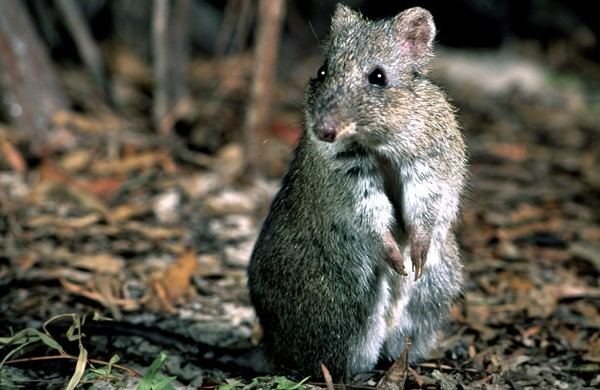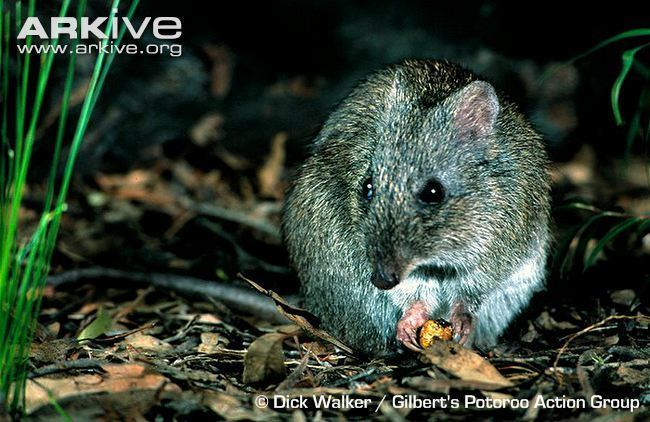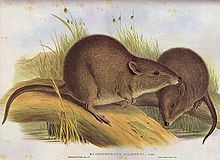Scientific name Potorous gilbertii Rank Species | Phylum Chordata Genus Potorous Higher classification Potoroo | |
 | ||
Similar Potoroo, Long‑footed potoroo, Marsupial, Mammal, Long‑nosed potoroo | ||
Saving endangered aussie animals gilbert s potoroo and hairy nosed wombat
Gilbert's potoroo (Potorous gilbertii), sometimes called the "rat-kangaroo" or "garlgyte", is Australia's most endangered marsupial and one of the world's most endangered mammals. It is a small nocturnal marsupial which lives in small groups or colonies. It has long hind feet and front feet with curved claws which it uses to dig for food. Its body has large amounts of fur which helps with insulation, and its fur ranges between brown and grey; the color fading on its belly. This potoroo has a long, thin snout curving downward that it uses to smell its surroundings; this trait is common in all potoroo species. Its eyes appear to bulge out of its face and look as though they are on an angle and its ears are almost invisible, buried under thick fur. Male and female body types are very similar and are both within the same size range. Adult females range in weight from 708–1205 g (including pouch young where present), whereas adult males range in weight from 845–1200 g.
Contents
- Saving endangered aussie animals gilbert s potoroo and hairy nosed wombat
- Discovery
- Habitat
- Diet
- Reproduction
- Population
- References

The current estimated population is a sparse seventy individuals. It was thought to be extinct until its rediscovery in 1994. The only naturally located population is found in Two Peoples Bay Nature Reserve in Western Australia, where they co-exist with quokkas. Small populations are also being established at Bald Island and Michaelmas Island.

Discovery

Gilbert's potoroo was first discovered in 1840 and named in 1841 after the English naturalist and explorer John Gilbert. Gilbert had collected several specimens at King George Sound in Australia, this potoroo being one of them. Gilbert's potoroo was not seen again for many years, even after a thorough search in the 1970s.

The species was considered extinct for 20 years before it was rediscovered in 1994 in Two Peoples Bay Nature Reserve. Liz Sinclair had been doing research on wallabies and caught the potoroo in one of her traps. She then compared her captured specimen with the skeletons of past potoroos and proved it was indeed a Gilbert's potoroo.
Habitat

Gilbert's potoroo was once widespread throughout south-west Australia, including the areas around King George Sound and near the Margaret River, but now is found only on the Mount Gardner headland at Two Peoples Bay. Within that area of less than 1,000 hectares, the species occupies four separate patches of long, unburnt, dense shrubland on the valley slopes. These areas are described as Melaleuca striata and Melaleuca uncinata shrubland, between 1.5 and 2.0 m tall with 70-100% canopy cover, and a dense layer of sedges including Lepidosperma sp. and Anarthria scabra beneath. The vegetation forming its habitat has not been burnt for over 50 years, so long, unburnt areas are thought to be necessary for the species. It is nocturnal and spends its days hiding in the dense thicket, rarely crossing open large areas.
Diet
Gilbert's potoroo is primarily mycophagous, meaning its diet consists of multiple varieties of truffle-like fungi. It may also consume fleshy fruits as seeds have been found in the scat, but it is not known how important this is to its diet. Australia has the majority of fungal varieties and the Gilbert's potoroo likes to eat a variety of them. From translocation of the potoroo, the species was found to survive on many different kinds of fungi, not limited to the species available in its habitat at Two People's Bay.
Gilbert's potoroo has sharp, three-toed claws that help it dig into the ground to unearth fungi. After digestion, the potoroo aids in spore distribution, as the spores germinate from its feces.
Reproduction
A female Gilbert's potoroo can have two babies in a year, while carrying only one at a time. It has the ability to keep a second embryo in a state of diapause while the first embryo is growing. If the first baby does not go to term, a second baby starts growing right away. The gestation period for Gilbert's potoroo is unknown, but is estimated to be similar to the long-nosed potoroo at 38 days. Since so few are alive today, much of the reproductive cycle for Gilbert's potoroo remains unknown. However, the main breeding period is thought to be November–December with similar breeding patterns to those of the long-nosed potoroo. Scientists have tried to breed them in captivity, but recent attempts have been unsuccessful, citing diet, incompatibility, and age as possible factors that influenced the lack of reproduction. Reproduction in the wild is thought to be progressing successfully as many females found in the wild are with young.
Population
After the rediscovery of Gilbert's potoroo, additional specimens were immediately taken into captivity to try to help to promote more young to be born to help increase the population. A few young were born in the first few years, but then breeding stopped due to age differences and a history of balanoposthitis, a disease that affects the male potoroo's penis and causes inflammation and ulceration if left untreated. This problem only exists among the wild population, however, not the captive population because of antibiotics.
In 2001, the Gilbert's Potoroo Action Group was formed to help in the education and public awareness of the potoroo. The group also helps with raising funds for the research and captive-breeding programs for Gilbert's potoroo.
In efforts to protect the remaining population, three Gilbert's potoroos (one male and two females) were moved to Bald Island in August 2005, where they are free from predation. Since that time, an additional four potoroos have been sent to establish a breeding colony.
Along with the dwindling number of the species after their rediscovery in Australia, one of the potoroos was found to have some sort of sickness when brought into captivity in early 2000. The scientists who had brought the young male potoroo and its mother into captivity found that the animal had significant loss of appetite, and lost 32% of its body mass within a few weeks. They had observed it moving in circles in captivity and behaving in an odd manner. They had also noticed symptoms of sporadic coughing fits and before its death had seen that the potoroo had actually gone into a state of hypothermia. In a later study of a long-nosed potoroo, the same symptoms were found and were likened to a fatal disease, cryptococcosis, which had been contracted while the animals were in the wild. This could also be a factor why the potoroo population is dwindling in the wild, because the disease could be killing the young before they are able to reproduce.
In 2016, Michaelmas Island, off the coast of Two Peoples Bay, was chosen as a new habitat location. The island's lack of predators was a key factor in its selection, which will provide the Gilbert's potoroo with a similar level of long-term protection enjoyed by the quokkas of Rottnest Island, also in Western Australia.
